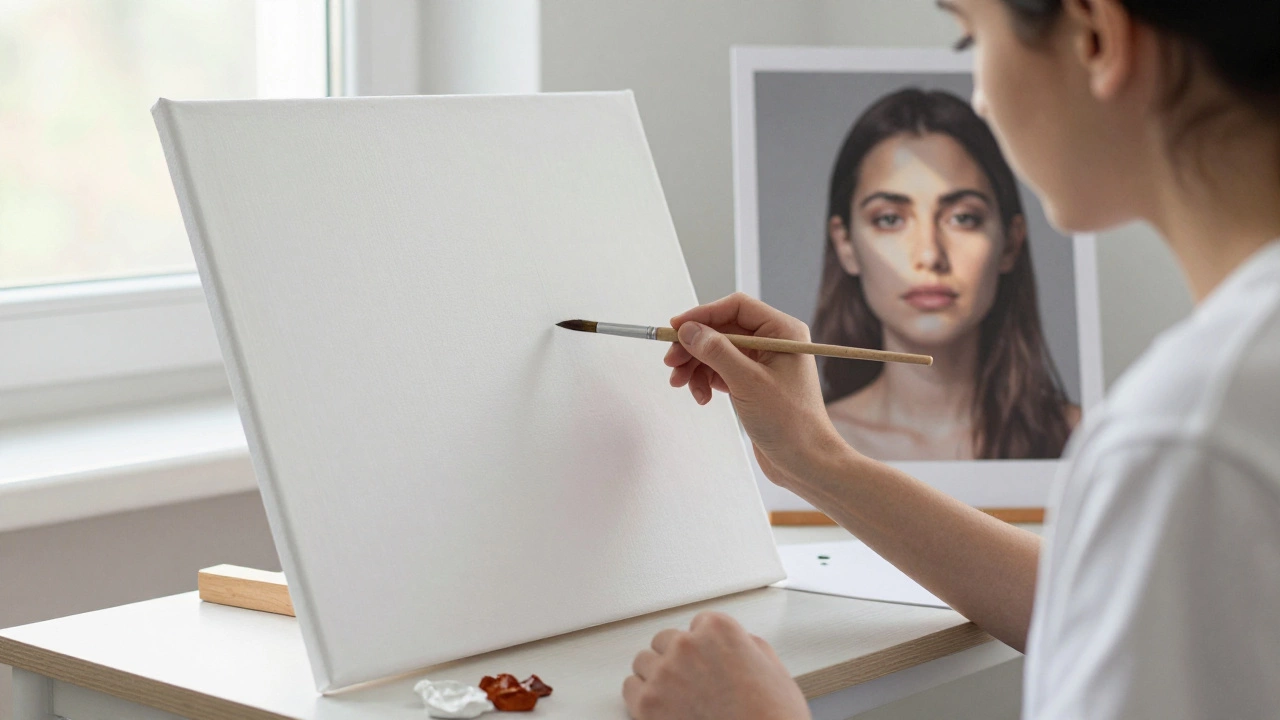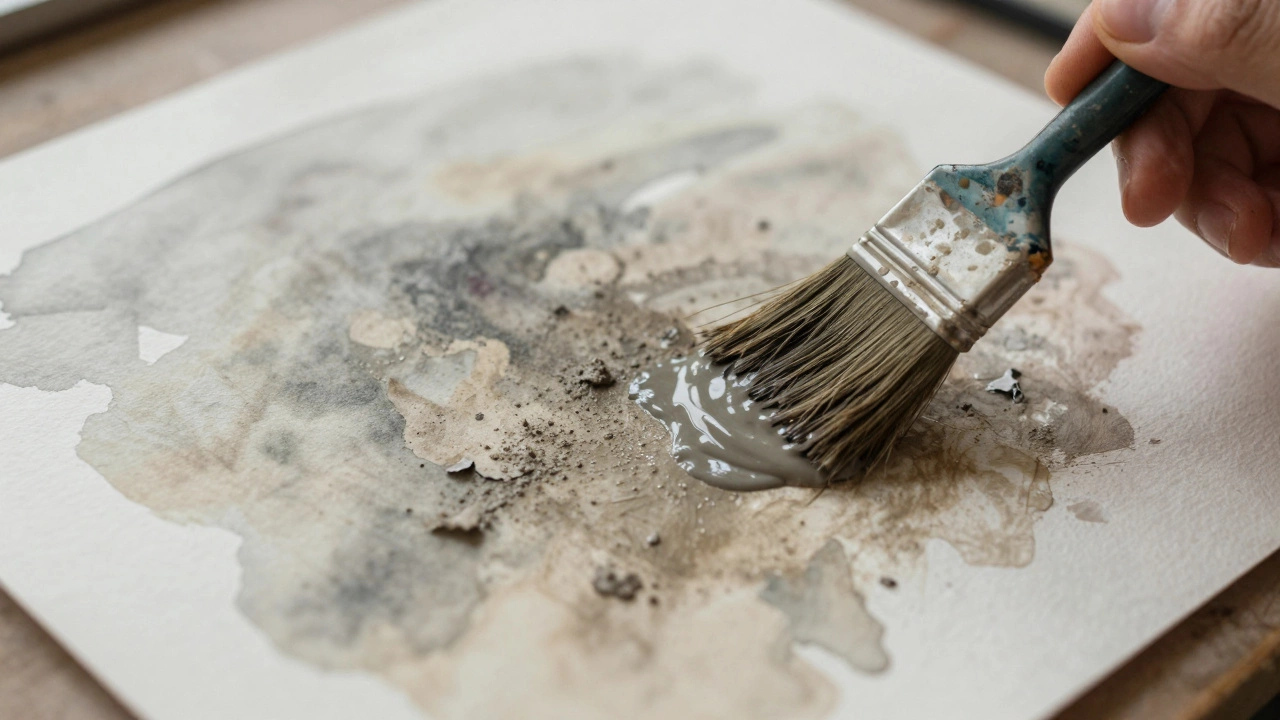Imagine you finally get your hands on that tube of high-quality oil paint. You’re itching to see color leap from canvas, but nothing happens when you add water. Frustrating, right? Oil paint doesn’t play by watercolor’s rules. No “just add water” magic here. You need to know exactly what gets those rich pigments moving and what gives your brushwork life. That’s where things get a whole lot more interesting—and, for beginners, a little overwhelming. Let’s cut through the confusion and break down exactly how you activate oil paint in ways that are straightforward, safe, and give you the results you crave.
Why Water Isn’t Enough: The Science Behind Oil Paint Activation
If you’ve ever tried to wash oil paint off your hands with water, you already know: it doesn’t exactly rinse away. Oil paint is composed primarily of pigment and a drying oil, usually linseed oil. Pigments are tiny colored particles—think natural minerals, powdered metals like cadmium or cobalt, or synthetic colorants. These get suspended in the oil, creating that thick, buttery paste we all recognize. Here’s where it’s different from watercolor or acrylic: those paints are water-based. Oil paint isn’t. The oil molecules repel water, so it beads right off instead of mixing.
This means any activation—making your oil paint usable, thinning it, cleaning it, or making it dry at your chosen pace—hinges on oil-friendly substances. These are called solvents and mediums. Solvents dissolve or thin oil, while mediums modify the paint’s texture or drying rate. Ever heard of turpentine or linseed oil in art class? They’re not old-school names for nothing. There’s real chemistry here. Letting you shape paint the way you want, blend for ages, or work fast, depending on what you use.
This difference makes oil paint so beloved. It’s why you can keep blending a sky for hours, compare that with the speedy drying of acrylics—not a chance. But with this flexibility comes choices. Which activator is right for you? Which is safe? Which makes your colors sing instead of sinking into a muddy mess? Time to dig deeper.
Traditional Solvents: Turpentine, Mineral Spirits, and the Pros and Cons
For centuries, artists reached for turpentine without a second thought. Turpentine is distilled from pine resin and does a killer job breaking down paint, cleaning brushes, and thinning that first paint layer (known as "lean" layers). Painters like Rembrandt and Van Gogh used turpentine, and it’s part of the classic smell you get walking into a serious studio. But let’s be blunt: turpentine can pack a punch. The fumes are strong and can be hazardous with repeated exposure. It’s also flammable. If you paint in a bedroom or shared family space, those risks start to matter.
A more modern option is odorless mineral spirits (OMS). These do the same thing—dissolve paint, thin mixtures, strip brushes—but with way less stink and lower toxicity. Art brands like Gamsol offer extra-purified versions that are safer if you love to paint without cracking open every window. Both turpentine and mineral spirits strip the oil and change how the paint handles. Thinned paint dries faster and goes on in smooth, transparent layers. Most professionals use this method for their earliest paint layers—think blocking in major shapes or sketching out ideas on a toned canvas.
But solvents have downsides, even the safer ones. They dry out your brushes (they break down natural hairs over time), and some sensitive folks notice dry hands or mild reactions. Plus, solvents carry their own environmental baggage. So if you hear oil painting and picture toxic fumes clinging to your curtains, you’re not alone. Still, many artists wouldn’t give up their specially balanced odorless medium for anything. The trick is using ventilation, gloves, and always closing the lid tight.
| Solvent Type | Main Use | Pros | Cons |
|---|---|---|---|
| Turpentine | Thinning, cleaning | Strong solvent, classic handling | Strong odor, toxic |
| Odorless Mineral Spirits (OMS) | Thinning, cleaning | Low odor, less toxic | Can still be irritating for some |
| Eco-Friendly Solvents | Thinning | Safer, less fumes | Slower drying, can change handling |

Mediums and Oils: Moving Beyond Thin with Linseed, Poppy, and More
What if you could activate oil paint with something gentler—maybe something that helps paint flow but also enriches color and extends working time? That’s where mediums come in. The simplest is more oil, usually the same type already in your paint. Linseed oil tops the list. It thins paint a touch, keeps it glossy, and slows drying so you can fuss with those details as long as you like. If you want less yellowing over time (a worry with pure linseed oil, especially in whites and pale shades), you might try safflower or poppy oil. Safflower is popular because it’s paler. Poppy oil dries slowest of all, which is great for ultra-smooth blending, but it can make thick layers risky.
Additives called mediums tweak things further. Mix linseed oil with a bit of OMS, and you get the classic fat-over-lean rule in action. Early layers are lean (less oil, more solvent), while later layers get fatter (more oil), so everything dries evenly. Ignore this, and your painting could crack like a pie crust as it cures. Fascinating fact: X-rays of old masters show tiny networks of paint fissures—traces of lost fat-over-lean wisdom. Some artists swear by stand oil (a thicker, polymerized linseed oil) for top layers because it gives insane gloss and helps brush marks stay put.
There are also pre-mixed mediums like Liquin or Galkyd. These speed up drying, smooth texture, and help with glazing (those glass-like transparent veils of color). They’re dead simple to use and favored by modern painters chasing both speed and reliability, especially in humid or unpredictable climates.
- Linseed oil: standard, versatile, slightly yellows over decades
- Poppy oil: less yellowing, slower drying, best for whites and lights
- Safflower oil: pale, moderate drying, all-around safe bet
- Walnut oil: slow drying, keeps colors clean
Here’s something fun: Leonardo da Vinci supposedly experimented with mixing walnut oil and beeswax to get unique effects. There’s still debate about the mysteries buried in those Renaissance layers.
Modern and Eco-Friendly Solutions: Safe Solvents and Water-Mixable Oil Paints
Times change, and so do safety standards. Lots of artists want to ditch solvents altogether, especially if they work in small apartments or have kids and pets. Enter water-mixable oil paints. Brands like Winsor & Newton Artisan make tubes with a modified oil binder—so they thin and clean up with water instead of harsh chemicals. Magic? Not quite, but close. The feel is similar to normal oils, but you avoid most fumes and chemical headaches. Some pros find their blending slightly different, maybe a touch less creamy. But if you’re careful with technique, you’d be hard-pressed to notice a huge difference once dry.
Eco-friendly solvents are gaining traction, too. Citrus-based formulas, like Citrus Turpenoid or Zest-it, promise the dissolving power of traditional turpentine but with a pleasant lemon scent and less environmental impact. They’re safer for skin and air and easier to dispose of responsibly (always check local regulations, though). Many artists love the peace of mind—plus, no getting dirty looks from roommates when you open the jar.
- Water-mixable oil paints blend with regular oil colors in small amounts (but never mix-in water with regular oils—it won’t work)
- Eco-solvents may dry slower, so test recipes on a practice panel first
- Some people develop allergies to citrus—if in doubt, wear gloves
- Rumor has it that studios in the Louvre now use citrus solvents exclusively for visitor safety
And here’s a cool twist: some digital-savvy artists start a painting using acrylics for a quick background, then switch to oils (with eco-solvents) for the real details. You get the best of both worlds.

How to Activate Oil Paint: Practical Tips and Favorite Tricks from Everyday Artists
Ready for the real-world scoop on getting oil paint moving? You only need a pea-sized blob squeezed on your palette, a brush, and your chosen activator. Most artists start by dipping the brush into a little solvent or medium—never dousing it. With solvent, go slow: just enough to see the paint start gliding onto the canvas. For details, switch to oil or medium so your brush doesn’t run dry or leave patchy marks. Think of solvents as the kickstarter for quick sketches and blocking, and oils as the finishing touch for color and detail.
Leaning toward solvent-free? Try painting “alla prima” (wet-into-wet) with straight-from-the-tube paint and add just a few drops of linseed or walnut oil as you work. If you use a medium, keep the ratios modest (about 10–20% medium to 80–90% paint on your brush is common). Go overboard, and your layers could wrinkle, or dry slowly for months—the stuff of urban painting legends.
When cleaning up, stick to solvents for deep cleaning brushes, or olive oil/soap for a greener option. For water-mixable oils, regular soap and water does the trick. Recycle or safely dispose of any rags or paper towels soaked in oil or solvent—they can combust if left bunched up (really, don’t test this at home).
- For slow blending, keep a small container of linseed oil at hand
- To prepare your canvas, lightly tone it with a thin turpentine/oil wash—that first layer dries fast and cuts glare
- Paint in thin layers early, thicker as you finish (classic fat-over-lean)
- Try a walnut oil "soap dip" after painting: condition brushes and keep bristles soft
- If your studio is chilly, warm your oil bottle in your hands—warmer oil flows more smoothly
Need inspiration? Painters in New York’s Art Students League often keep small mist sprayers of medium near their easels. Patrick, one of the regulars there, swears by a 70/30 linseed-to-stand oil mix for luminous skin tones. Anna, across the room, won’t touch solvents but paints directly with Zest-it and walnut oil and rarely waits more than a night for her work to dry. There’s no single right answer—the best activator for oil paint is the one that matches your vibe and gets those colors leaping off the canvas just the way you want them to.
Long story short? You don’t activate oil paint with water—you use the right combo of solvents, oils, or mediums, chosen for your safety, goals, and style. That’s where oil painting turns from technical process to personal expression, and that’s why so many artists keep coming back to that intoxicating, unpredictable smell of a freshly squeezed tube.





